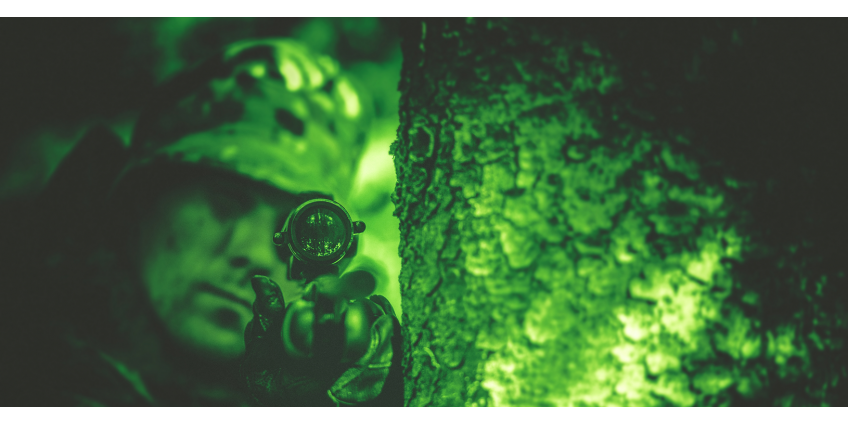
This product is not exportable outside the United States.
By adding this item to cart, you agree and acknowledge the Export Policy and confirm that you are a person in the United States with no intentions to illegally export the device.
This product is not exportable outside the United States.
By adding this item to cart, you agree and acknowledge the Export Policy and confirm that you are a person in the United States with no intentions to illegally export the device.


0

0


Night vision technology today is a familiar and common thing for us. She has become a part of popular culture and even an ordinary housewife. Today, seeing a green glow on the screen, we immediately realize that the film's heroes participate in a night operation.
We all warmly remember how we played video games in childhood, eliminating terrorists in the night mode. From the legendary Delta Force to Call of Duty and hundreds of other awesome games, we've gotten into the role and enjoyed unique military technology.
Today, thanks to modern advances in science, we can not only feel in reality the impressions that games teased us during childhood but also become the owner of such a fantastic device. The increased opportunities, which today are limited only by our bank account and imagination, still do not answer some questions.
For example, be honest: have you ever wondered why the color of night vision is green? Not red, not blue, not purple, after all? What is this - a conspiracy of the Freemasons, the intrigues of a secret government, or a symbolic attribute? Let's figure this out.
It is enough to study the peculiarities of the human eye’s perception of different colors to understand why night vision goggles are green. Green is the color most related to them, and long-term observation of it will not lead to pain and rapid eye fatigue. According to scientists, people are able to see many more shades of green than any other color. In this regard, green night vision is the most common.
Let's start over. Night vision technology has various uses in the civilian and military sectors, as it can be used for security, surveillance, and numerous outdoor activities. Nightvision was first developed for military use in the 1940s and was readily utilized during Military conflicts in the Korean and Vietnam wars. These devices were large and cumbersome but were cutting-edge technology that empowered militaries with the first advantage of seeing in the dark. One of the first images that comes to mind when hearing about NightVision is the green color of the visual field. This article will provide some backdrop on the development of night vision and the reason for the green field of view.
The inability to conduct hostilities at nightfall and the difficulty of observing at night created problems for conducting any active hostilities throughout civilization's history. This made it impossible to attack operations in the dark and endangered the troops. A sabotage group in the rear becomes more dangerous when you do not see it.
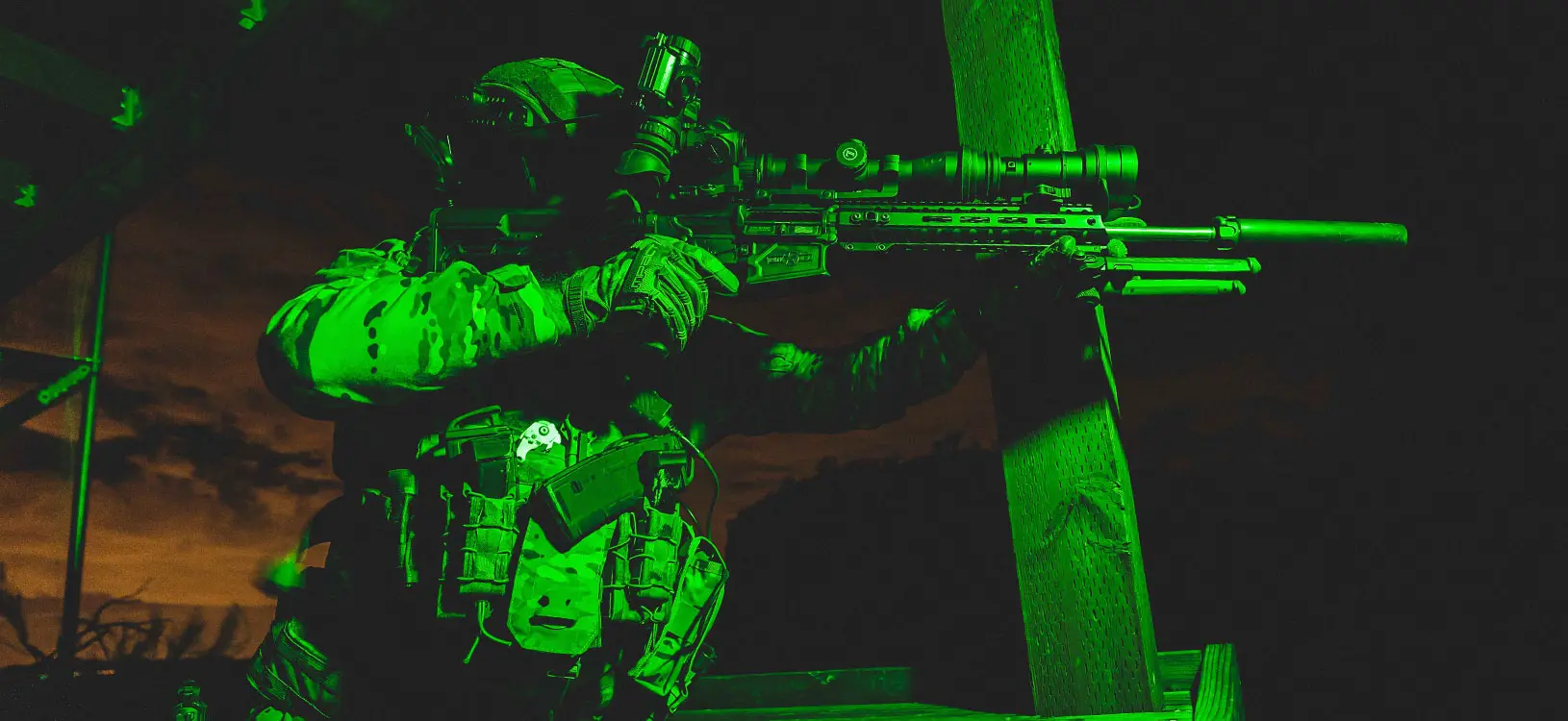
It is only logical that the best minds associated with the military industry worked to expand visual identification possibilities. And in the 20th century, the technological revolution began to bear fruit.
The first practical night vision devices were developed in Germany in the mid-1930s and used by German tanks and infantry during World War II. Meanwhile, U.S. Military scientists developed their own night vision devices that first saw use during WWII and the Korean War.
These were devices that can hardly be called devices in their modern sense. Huge, bulky, impractical, and very fragile, they were not so much practical as the very fact of their existence inspired them. Namely, this equipment became the starting point in developing the NV industry and received the name “Generation 0”.
At the heart of the generation was the Holst Glass, the first engineering prototype developed by Holst and his group at the Dutch company Philips in the 1930s. During World War II, German troops began to actively implement equipment into their tactical arsenal.
But even before Holst's experience, work on creating such devices was actively carried out by all developed countries. And because of this, the Hungarian scientist Kalman Tihanyi deserves special mention.
Working in Great Britain in 1929, he invented the infrared-sensitive electronic television camera intended for air defense. And, given how much the island suffered from the Germans' brutal air raids, any invention that helped to minimize losses and damage from bombing was a real scientific and civilian breakthrough.
The characteristic result of even low-performance night vision equipment is a tremendous advantage on the battlefield. For example, the Nazis defeated the Communist troops in battles in Lake Balaton, Hungary. The losses were enormous, and the Germans' night strikes' accuracy was so impeccable that the Russians threw all their strength into thinking over a strategy of protection from the enemy's absolute sight.
The communists did not come up with anything better than flashing the German army's positions with anti-aircraft searchlights, but, honestly, even such a primitive solution turned into a very effective method. True, the backward Soviet army, supported by the allies, could not technologically withstand the Axis countries, making the communists feel very defective. Therefore, to this day, in Russian historical literature, the use of searchlights is associated with a psychological attack on the Nazis but not the trying to attempt to resist modern technologies, not with the help of science but with the help of improvised means.
These “Generation 0” devices brighten a scene using active infrared. Soldiers carried an IR illuminator to shoot a near-infrared light beam that reflected off objects, bounced back to the lens of their scope, and created a visible image of what they were looking at. The illuminators used by the German Nachtjägers, or "night hunters," were about the size of dinner plates and required a large power supply carried on the soldier’s back.
It sounds incredibly impractical and difficult. But in those days, it was not just a breakthrough. This was a real and unique advantage on the battlefield.
It must be understood that such a complex technology cannot be compared with other branches of military affairs. For example, pistols and revolvers' operation and design principles have not changed significantly since the late nineteenth century. That is, the beautiful and shiny Desert Eagle or the compact and lightweight Glock you can buy today is no different from the models our ancestors used 150 years ago. With night vision, things are very different for obvious reasons. The principle of their work, of course, has not changed. It copies the mechanisms of vision of domestic cats. However, making the elements compact and cheap took time and scientific advances.
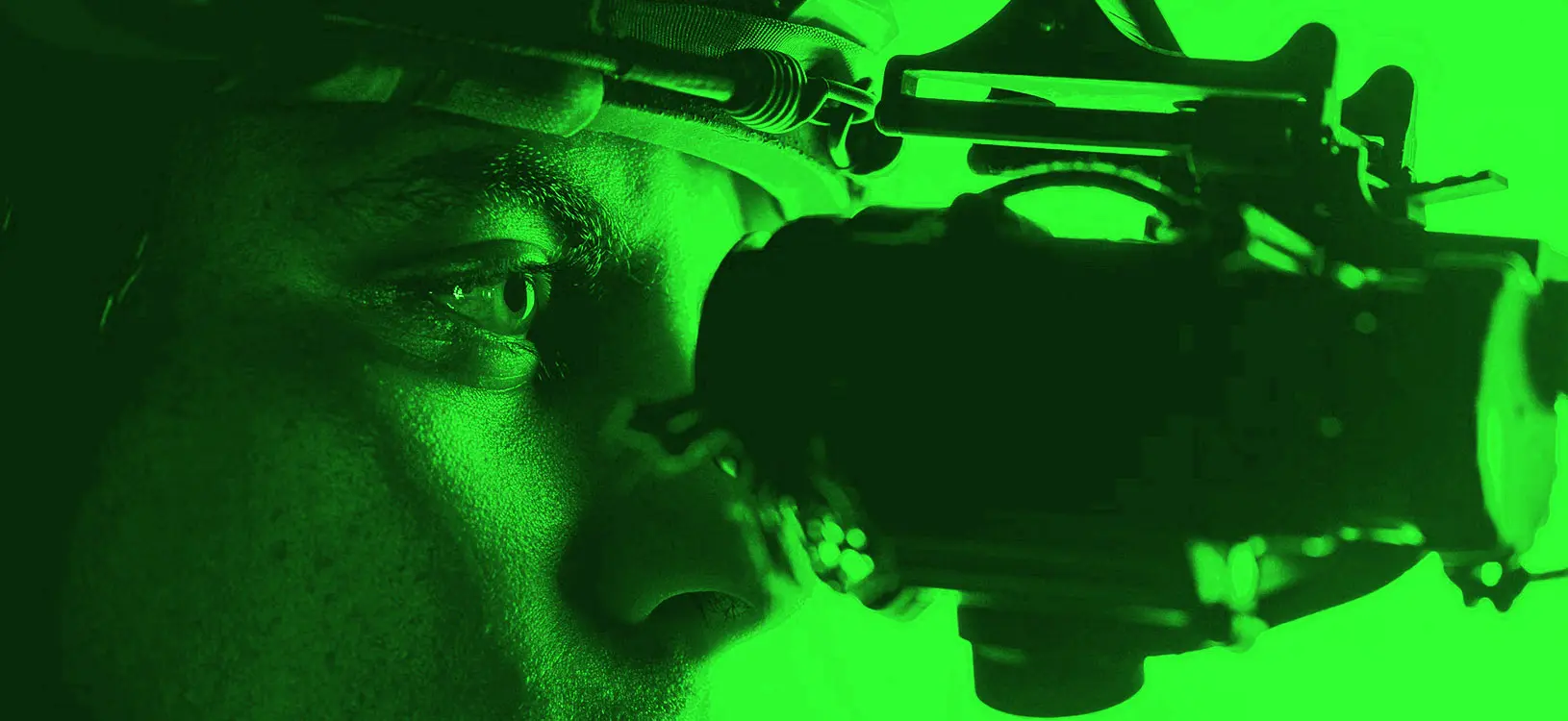
The technology made considerable leaps in the following decades. By the time the U.S. entered the Vietnam War, many troops were outfitted with passive "starlight scopes" that used to image-intensify tubes to amplify available ambient light (usually from the moon and stars, hence the name) and produce an electronic image of a dark area.
To understand how far we have gone, we can mention that you can purchase a kit in the store that will allow you and your children to build a primitive night vision device. It will be functional and working, and its characteristics will not be much inferior to the first samples of the zero generation.
There are active and passive night vision devices. Their operating principle has minor differences observed in the initial stages. With the help of a lens, passive devices capture dim light entering the inspected area, and active devices capture the reflected rays of the infrared illumination. Next, both types of optics transform light into a stream of photons. They enter a unique converter, where a flow of electrons is formed on their basis. The latter are accelerated using a photomultiplier tube and increase in number. At the next stage, the electrons hit the phosphor screen, where photons are knocked out of the stream under the influence of electricity. After all of the above transformations, there are many more photons than initially, forming a brighter and clearer night vision image of the green light.
Nevertheless, let's return to our main question, "Why is the image color of the night vision device green?" And, if you think it's because green, according to popular theory, is preferred by geniuses, you're mistaken.
There are two main technologies used in the development of night vision. The first type is active illumination technology, which couples imaging intensification with a source of illumination in the near-infrared band. The second technology, image intensification, is the answer to why night vision is green. Image intensification technology gives us that famous bright green light in night vision goggles.
If this sounds complicated and confusing, then it’s time to delve into the essence of visualizing objects hidden by the darkness of the night. And we are talking about darkness, as your device will become useless if you use it in fog, blizzards, or even heavy rain. Science has other solutions for these conditions.
But what makes the symbiosis of sophisticated equipment in a night vision device? It maximizes the amount of light received from natural sources such as starlight or moonlight and “amplifies” it in night vision devices to get a clear image. Unfortunately, this means that night vision goggles with this technology can’t work in complete darkness since it doesn’t amplify the light. Instead, it illuminates it to a level the human eye can detect. When photons hit the lens at the front of night vision goggles, they still carry the light of all colors. But when they are turned into electrons, they lose that information, and incoming color light is turned into black and white. But why is night vision green, then?
The main reason is that the image intensification screen inside the device is made of phosphor. This substance is used because of its luminance effect, and when struck by electrons that don’t carry color information, it glows bright green. As the electrons pass through the tube, they flow through a microchannel plate, a disc with millions of microchannels. Striking these microchannels with voltage bursts causes the motion to increase rapidly, forming dense clouds of electrons that intensify the original image. These same electrons then strike a screen coated with / phosphor at the end of the tube. The energy from these electrons creates a greenish image on the screen inside the device. Green phosphor is used because the human eye is most sensitive to the green color pallet and distinguishes more shades of green than any other color.
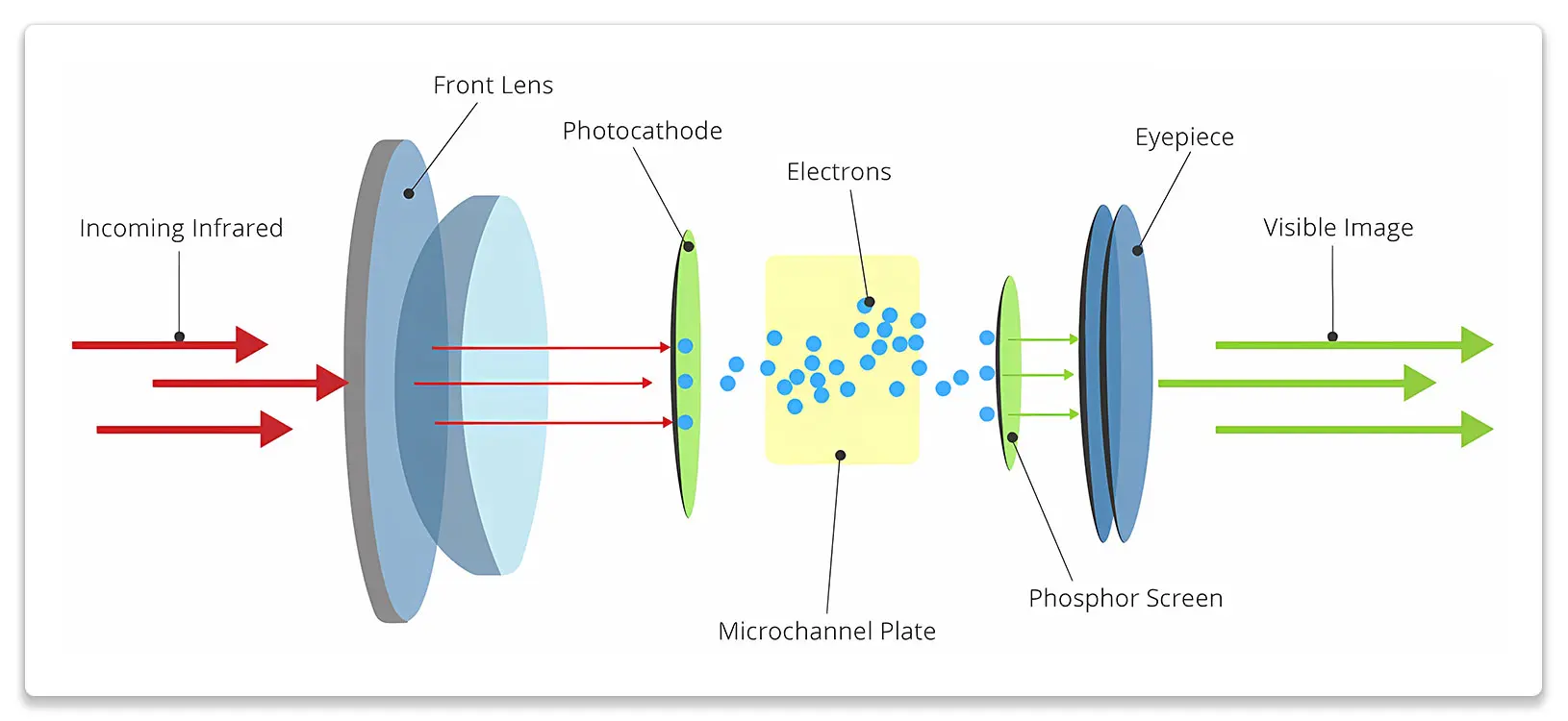
Everything is so boring and prosaic. Of course, we would like the answer to this question to be more romantic and mysterious, but like most answers in our lives, it is logical and even boring.
The utilitarian meaning of green light is not limited to this. When decoding an image from the black-and-white spectrum, the flow of electrons is no longer as intense, which means that the device spends less energy to render the image. This leads to an increase in the operating time of your device. Saving energy is sometimes a priority, given the conditions in which the device is usually used and the tasks performed with its help. Besides, when we talk about the range of perception of green shades in the human eye, we cannot underestimate this factor. Even for the average human eye, this is a huge advantage. And if you work with equipment continuously, then over time, you will be surprised at how many details you will discover in the mysterious green glow. The human body is a fantastic tool, and it is capable of constant surprises. For example, people who constantly work with color, such as artists, see up to 400 variants of only green.
Also, this color scheme is similar to the effect of a children's night light. In addition to the calm range and the unobtrusive glow for the brain, the eyes will get tired of it much more slowly. This means you will maintain a reaction and full functionality for longer.
We do not advise you to discard buying a device with a black-and-white display gamut. Based on the facts above, our pick is a classic. It all depends on the first rule of buying a night vision device - understand the purpose for which you need it. The chances are good that contrast is more important to you. It is better displayed in a monochrome mode that is more familiar to the human eye. Therefore, never deprive yourself of choice.
A phosphor screen consists of many layers. Each has different phosphors, allowing you to achieve the desired effect and create a high-quality image. Depending on the wavelength of light, the phosphor screen can have a different color, which the manufacturer of night optics wants. Most often, they are made green, red or blue. A phosphor screen is an essential element when operating all-night vision devices. It converts the enhanced flow of electrons into photons, forming the final image.
White and green phosphors are actively used in modern night vision devices. Both of them have a lot in common, but at the same time, they are very different from each other. Each has several advantages that make them an ideal option for specific situations. White and green phosphors combine the ability to enhance the image and make night optics work effectively in low-light conditions. However, neither of them can cope with complete darkness. Having learned about the standard features of white and green phosphors, let's now discuss their differences and critical advantages in more detail.
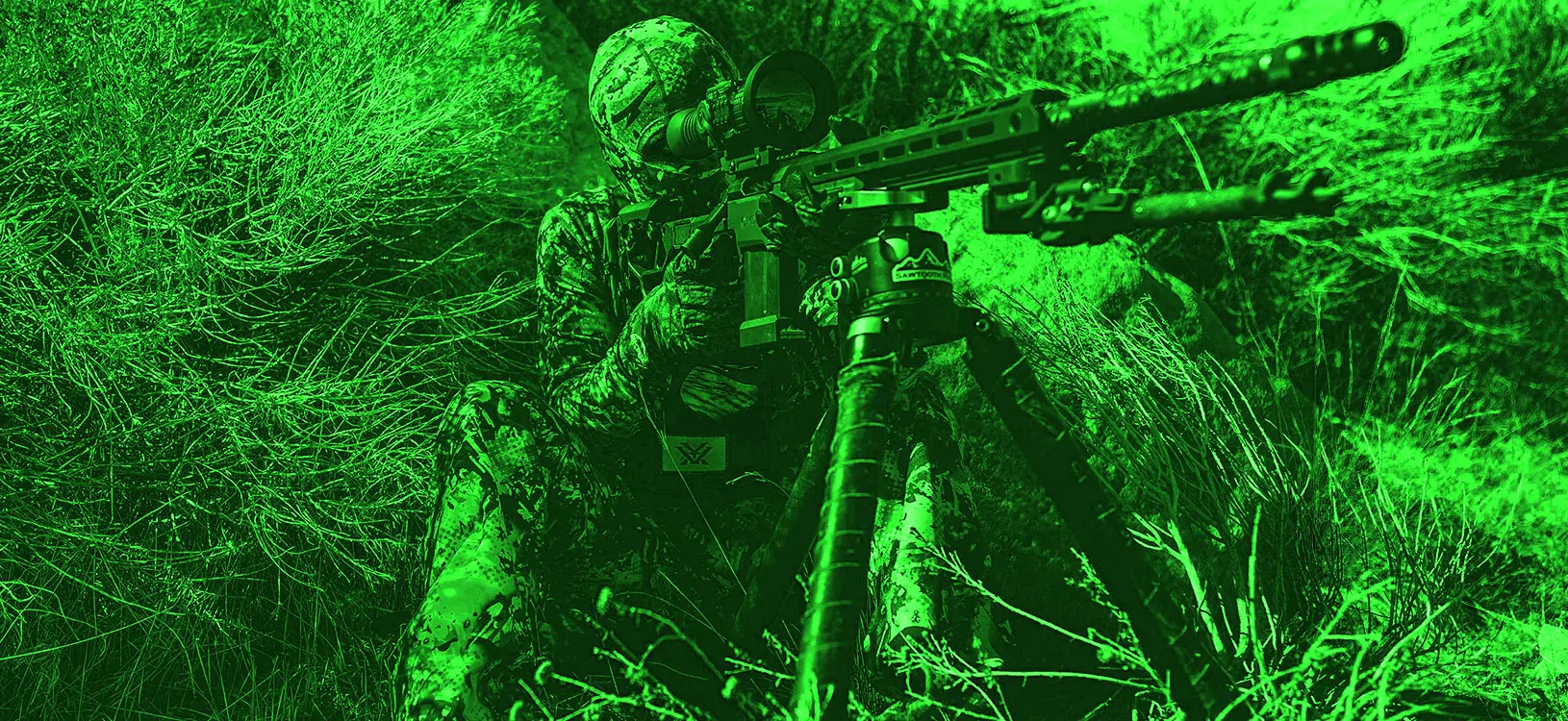
To understand why NVGS is green, it is enough to consider the main advantages of this color. First, it should be noted that the human eye perceives night vision green light better. People can distinguish much more of its shades, which positively affects the clarity and contrast of the generated image. According to reviews from users of various types of night optics, models with green phosphor provide a visually better picture than optics with white phosphor. This does not mean that the first is much better than the second, but for our eyes, the ability to see an image of a green color is a more common option.
Another essential advantage of green phosphor optics is lower cost. This is explained by the fact that many more such devices are produced than models with white phosphor. Oversaturation of the market with a particular product leads to an inevitable decrease in price, which is observed in the case of green phosphorus. Additional advantages include low false alarms and the ability to form a high-quality image under unfavorable operating conditions for night optics (for example, in heavy rain).
In addition to the classic green color night vision goggles, there are others. The most commonly used alternative is devices with white phosphor. They appeared later than models with green phosphor; therefore, they are considered more modern and advanced. This is partly proven by the large number of benefits that owners of such night optics receive. Many people call the main advantage of obtaining an image in a more natural black-and-white color. Traditionally, it is easier for humans to perceive it than green, which increases comfort when using the device.
The next advantage is low power consumption. Models with white phosphor save battery energy better than devices with green phosphor, enabling NVDs to work autonomously for longer. This will be especially important in cases where recharge is impossible. Also among the advantages is the ability to create high-quality images in the lowest possible light.
Over the last 70 years, night vision has made significant advancements in size, clarity, visibility, and price. With continual technological advancements, several breakthroughs have been made in development, and it will be exciting to see where the night vision industry goes.
But, in any case, the main direction for us is clear: reducing and lightening devices, reducing the cost of their components, and, as a result, increasing the availability of night vision devices. This is great news, as the devices' applications are growing with their development. And today, they are not limited to military purposes and hunting.
Today, everyone can feel like Sam Fisher and plunge into childhood memories created by games and action movies, feeling a mysterious green glow that leaves no chance for the darkness to hide something.
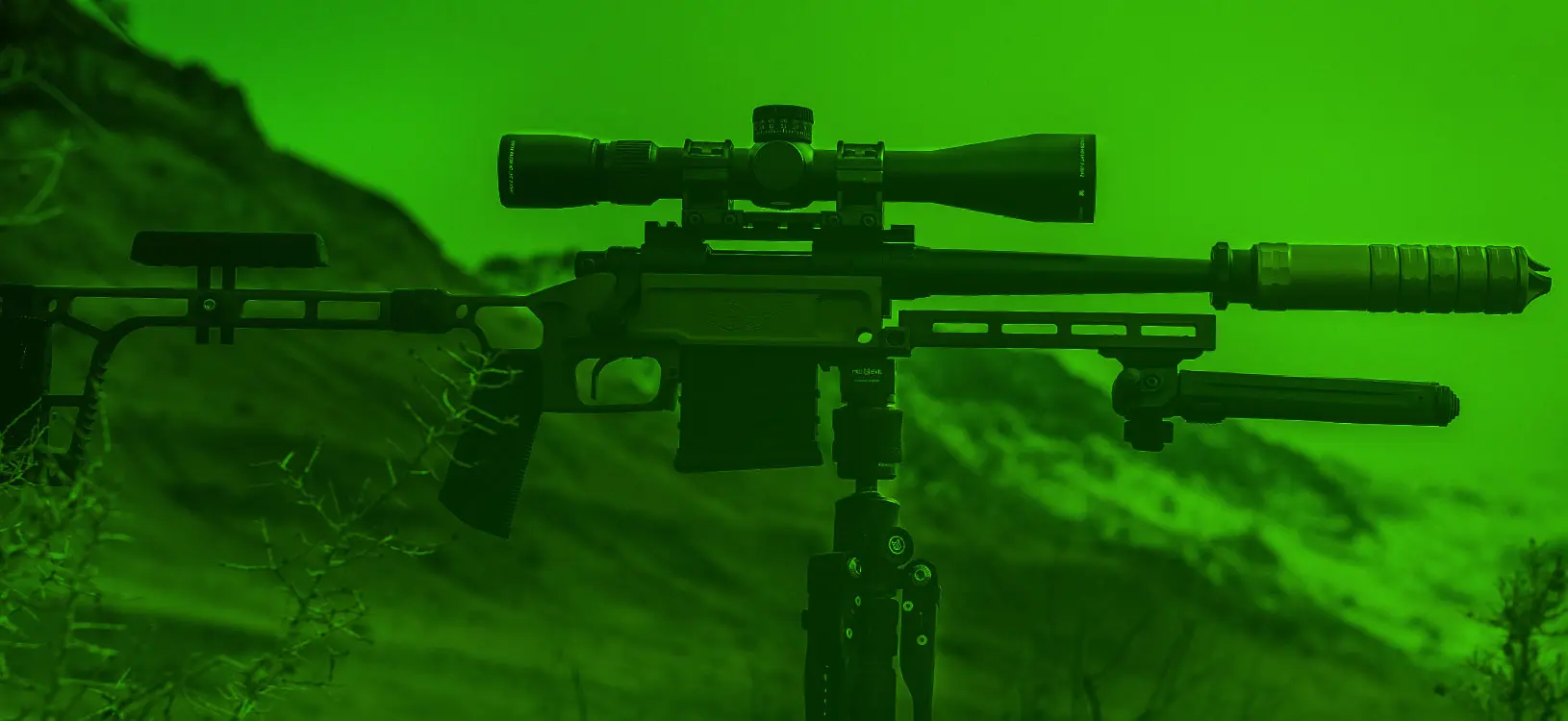
The color green is used because the human eye can distinguish many more shades of it than red.
Night vision goggles produce an image of green color, which is better perceived by the human eye.
Night optics with white phosphor are a more modern development, so they are considered a priority option in most situations. However, to solve some simple problems, it would be more advisable to use models with green phosphor.
Modified: Aug 12, 2024 | 09:40 pm
Table of contents
Featured Articles
What are the night vision devices, how they differ and what are the advantages of each - our article is about it. We’re going to talk aboutthe monocul..
You've probably heard about scientists inventing lenses for night vision. In this article, we will tell you about this technology and how it works...
Know more about night vision and principles of its work with www.agmglobalvision.com..
Focusing on variances in technology within security cameras, this addresses how security cameras work utilizing night vision technology..